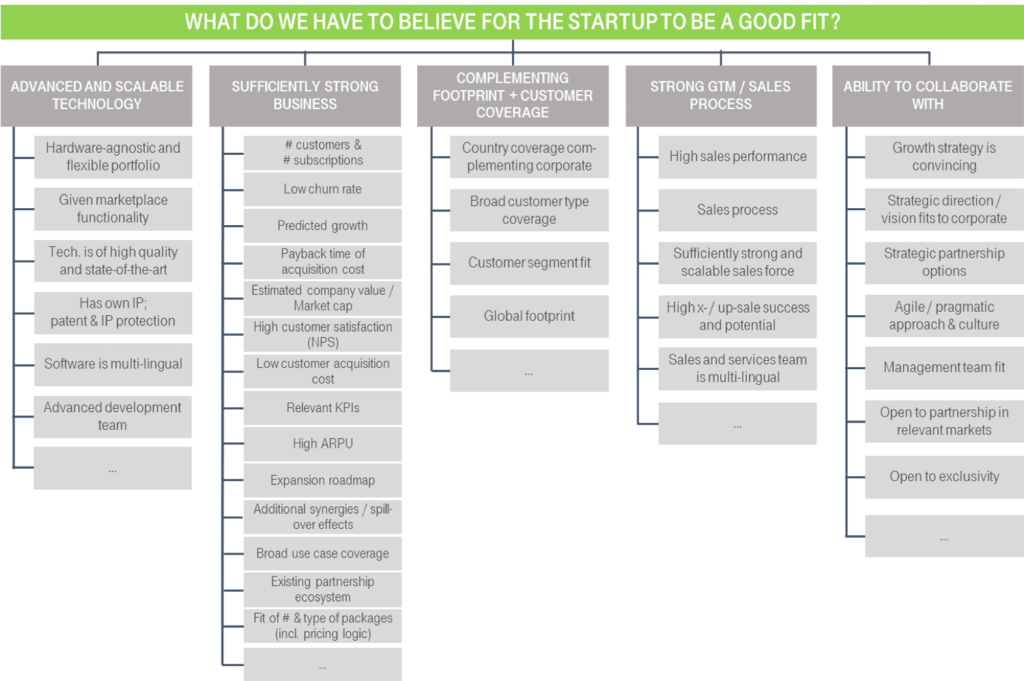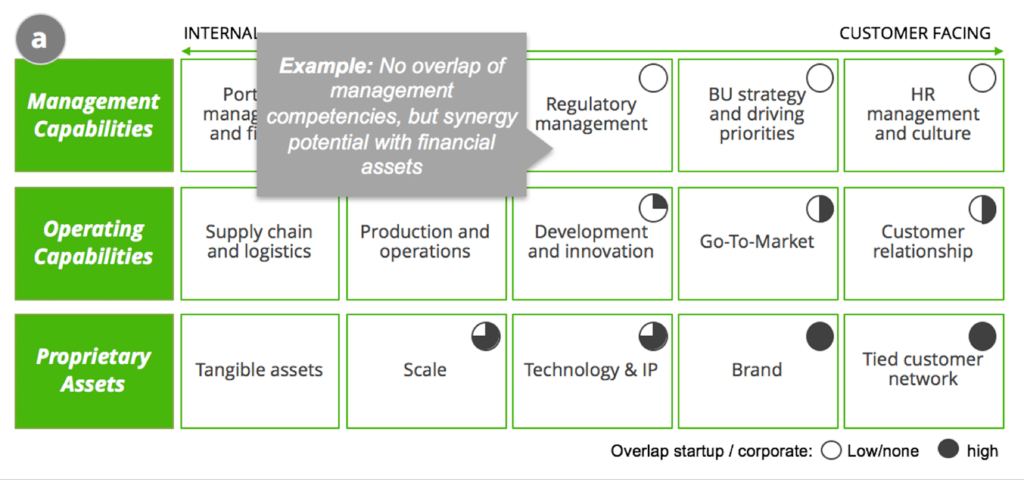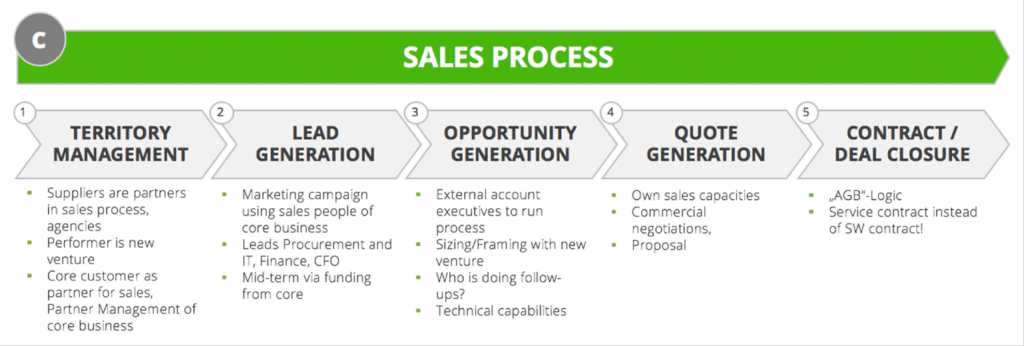Five essential success criteria corporate startup CEOs should keep an eye on within the first 100 days
Beyond venture capital and M&A, corporate ventures have become the third pillar for incumbent corporations to innovate and grow their business with new (digital) business models. Since 2015, Excubate has been supporting corporate clients to successfully build and scale their own startups. Drawing from this experience, we have identified five essential action areas every corporate startup CEO should bear in mind when building a new venture.
While some of those action areas are valid for any startup out there, the context a corporate startup navigates in brings unique challenges to the table. To list some of them: Setting up the right governance model, defining the ‘organization’s spine’, making cultural fit a top hiring criterion, avoid running into the ‘building trap’, and getting your brand out there. Of course, this list is far from being exhaustive and highlights Excubate’s view on the most important topics. For each area we have identified concrete actions to take within the first 100 days of building a startup. We consolidated all of these in a “100 day plan to corporate venture building”. Learn more about the watchouts in this article.

1. Set up the right governance model
The relationship between a corporate and its startup is tricky. Best case, the corporate equips the startup with an unfair advantage to succeed in the market. Worst case, a mismanaged relationship and governance can nip the startup’s potential in the bud. Therefore, corporate startup CEOs need to define the right governance model with corporate leadership as early in the process as possible. Key areas to agree upon are oversight and responsibilities among both parties, organizational design and reporting structure, management accountability and authority, performance, and incentives. In all dimensions, it is key to come to a preferably simple model which ensures an appropriate degree of freedom for the corporate startup – and of course, to adhere to it.
Within the first 100 days of the startup, corporate startup CEOs should especially aim for ensuring authority on financial transactions and corresponding processes. From our experience, corporate startups should be empowered to independently conduct financial transactions (at least up to a certain amount) to speed up the acquisition of the gazillion things that need to be acquired within the first 100 days – or else CEO’s might find themselves and their team waiting for essential tools or even a coffee machine because they are stuck in corporate purchase processes.
2. Define the ‘organization’s spine’
Drawing the right boundaries isn’t only important between corporate and startup: also within the startup itself, CEOs should establish ‘guardrails’ which work as underlying principles for future development of the company. With the early leadership team, CEOs should jointly agree on company vision and objectives, the targeted organizational design, ways of working and company culture. These guardrails function as the company’s north star, providing both leadership and the team with guidance on where the company is heading towards.
Of course, they will be subject to change over time. But from our experience it is advisable to set up an initial version of guardrails within the first 100 days. Defining your cultural guardrails early on will help tremendously in onboarding new employees as it provides them with guidance. With rapidly growing team size, it will become increasingly difficult to align and establish a harmonious culture the longer you wait. Plus, quite frankly your team will become busy with operational tasks, focusing on getting the solution to the market. Having guardrails established by then allows for smoother processes and ensures that your team’s focus remains on creating value for customers.
3. Make cultural fit a top hiring criterion
Your hires have a tremendous effect on the company – not only in terms of direct success but also in terms of the company culture developing. They will shape the working and communication style of your future organization and influence your ability to attract and retain needed talent. For small, young companies, the cultural fit of every new employee is especially important as one single misfit can impede the entire intended organizational culture.
Therefore, especially for key hires within the first 100 days, make cultural fit a top hiring criterion to ensure new hires bring the ‘right’ mindset: hands-on, can-do mentality and pushing for outcomes not processes. From our experience, the proverb ‘hire slowly, fire quickly’ holds true. We recommend to initially fill positions in an interim way with freelancers rather than compromise on quality of new hires in the long run.
4. Avoid running into the ‘building trap’
Getting an MVP out as fast as possible to make valuable learnings is key for startups. One shouldn’t get stuck in analysis paralysis. However, from our experience it pays off to take the time to validate assumed customer needs and your initial solution thoroughly enough. To avoid running into the ‘building trap’, don’t ramp up product development too early. Product development needs input and costs money – chances are high you will develop features with only little value for customers just to ‘keep the machine up and running’, leading to a self-fulfilling prophecy (“the start-up won’t fly”) and/ or inevitable pivots later.
During the first 100 days we recommend hiring external software development firmsf needed, get additional resources on board to remain flexible with your product development, like UX researchers. Also, from our experience it’s essential to build up customer feedback structures to be able to continuously validate solution ideas already early on.
5. Get your brand out there
Especially in corporate context, a lot of startups tend to operate in stealth mode for too long and don’t disclose their ambition openly. One potential reason can be hesitance of the corporate to go to the market –or even to approach existing corporate clients– without a high gloss polished brand and still premature products. However, we have seen that doing exactly that early on is a key factor for success. From our experience, it’s essential to start talking to customers early on –even for just communicating the company vision– to get timely feedback on ideas and build up crucial relationships to potential future partners.
Ideally, we recommend establishing and getting your core-brand out within the first 100 days. If you find yourself struggling due to prolonged alignment with e.g., the sponsoring corporate, we suggest to either create an interim brand appearance (you can always pivot later) or to agree on a company brand and keep it separate from future solution brands.
From our experience as a company builder, taking these five actions early in the venture building process will save you a lot of trouble later. As mentioned, this list is far from being exhaustive. Excubate has a battle-proven approach for successfully building, launching, and scaling your new business models within 6-18 months. We’ve consolidated our learnings into the Excubate 100-day plan for corporate venture buildingwhich includes the most important deliverables, methods, tools, and watchouts to help you navigate through the first 100 days and ramp up your corporate startup with the steepest slope possible. Learn more about the Excubate venture building approach on our website.
Do you want to know more? Then get in touch with us!







